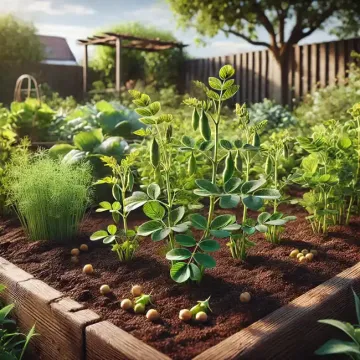History of Chickpeas
Chickpeas are one of the oldest cultivated crops in human history, with records of their use dating back to ancient Mesopotamia around 7,500 years ago. Originating in the Middle East, chickpeas have since spread across the globe, becoming a staple in cuisines from India to the Mediterranean. They are prized for their high protein content and ability to thrive in arid conditions, making them a crucial crop in many regions.
Health Benefits of Chickpeas
Chickpeas are packed with nutrients. They are an excellent source of plant-based protein, dietary fiber, vitamins, and minerals, including iron, phosphorus, and folate. Regular consumption of chickpeas can support heart health, aid digestion, and help regulate blood sugar levels. Their high protein content makes them a popular choice among vegetarians and vegans, while their fiber helps promote a healthy gut.
Varieties of Chickpeas
There are two main types of chickpeas: Desi and Kabuli.
- Desi Chickpeas: These are smaller, darker, and have a rougher exterior. They are primarily grown in India and Ethiopia and are more drought-resistant. The Desi variety has a slightly higher fiber content and is often used in split form to make chana dal.
- Kabuli Chickpeas: Larger, lighter in color, and smoother in texture, Kabuli chickpeas are commonly grown in the Mediterranean region and the Americas. They are the variety most commonly used in making hummus and other dishes in Western cuisines.
Planting Chickpeas in the Home Garden
Chickpeas are best grown in cool weather, making them suitable for planting in early spring or fall, depending on your climate. They need a growing season of at least 90 to 100 days of cool, but not freezing, weather.
- Soil Preparation: Chickpeas prefer well-drained soil with a neutral pH of around 6.0 to 7.0. Loamy soil is ideal, but they can also grow in sandy or clay soils if amended with organic matter. Ensure the soil is not too rich in nitrogen, as chickpeas are legumes and can fix their own nitrogen. Over-fertilizing with nitrogen can lead to excessive foliage growth at the expense of pod development.
- Planting: Sow chickpea seeds directly in the garden, as they do not transplant well. Plant the seeds 1 to 2 inches deep and space them about 3 to 6 inches apart in rows that are spaced 18 to 24 inches apart. Chickpeas need full sun to thrive, so choose a location that gets at least 6 to 8 hours of sunlight per day.
- Watering: While chickpeas are drought-tolerant, they still require consistent moisture during the growing season. Water the plants deeply but infrequently, allowing the soil to dry out between waterings. Overwatering can lead to root rot, so it's essential to strike a balance.
- Support: Chickpeas are bushy plants that typically reach about 1 to 2 feet in height. They usually do not require support, but if your garden is in a windy location, staking or using a low trellis might be beneficial to prevent the plants from toppling over.
Caring for Chickpea Plants
Once established, chickpeas require minimal care. Here are some tips for ensuring a healthy crop:
- Weeding: Keep the garden bed weed-free to prevent competition for nutrients and water. Mulching around the base of the plants can help suppress weeds and retain moisture.
- Pests and Diseases: Chickpeas are relatively resistant to pests and diseases. However, they can occasionally be affected by aphids, root rot, or fungal diseases. Regularly inspect the plants, and if you spot any issues, treat them with appropriate organic pest control methods or fungicides.
- Fertilization: As nitrogen-fixing plants, chickpeas do not require much fertilization. If your soil is particularly poor, a light application of compost or a balanced organic fertilizer at the time of planting should be sufficient.
Harvesting Chickpeas
Chickpeas can be harvested in two ways: green (for fresh eating) or dry (for storage).
- Green Harvest: If you prefer to enjoy chickpeas fresh, harvest them while the pods are still green, and the seeds inside are tender. You can eat green chickpeas raw, boiled, or roasted.
- Dry Harvest: For dried chickpeas, wait until the plants turn brown, and the pods are dry and brittle. Cut the plants and hang them upside down in a warm, dry place to finish drying. Once fully dry, thresh the plants by shaking or gently crushing the pods to release the seeds. Store dried chickpeas in an airtight container in a cool, dry place for up to a year.
Culinary Uses of Chickpeas
Chickpeas are incredibly versatile in the kitchen. Dried chickpeas can be cooked and used in soups, stews, curries, and salads. They are the main ingredient in hummus, falafel, and many Mediterranean dishes. Green chickpeas can be enjoyed fresh, added to salads, or roasted as a snack. The flour made from chickpeas, known as gram flour or besan, is also widely used in baking and cooking, especially in Indian and Middle Eastern cuisines.
Growing chickpeas in your home garden is a rewarding experience that can provide you with a sustainable, nutritious food source. Whether you're looking to expand your garden with legumes or experiment with a new crop, chickpeas are an excellent choice for gardeners of all skill levels. With a little care and attention, you'll enjoy a bountiful harvest of these ancient and nutritious legumes.

